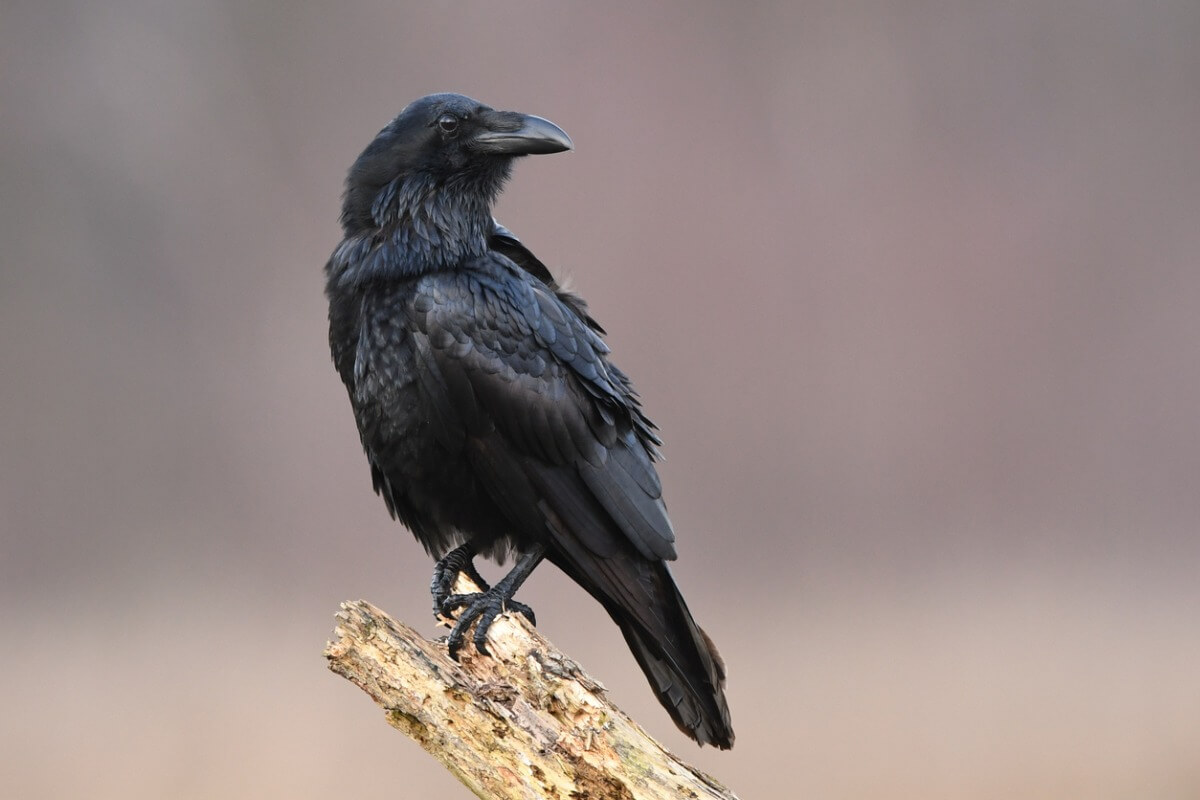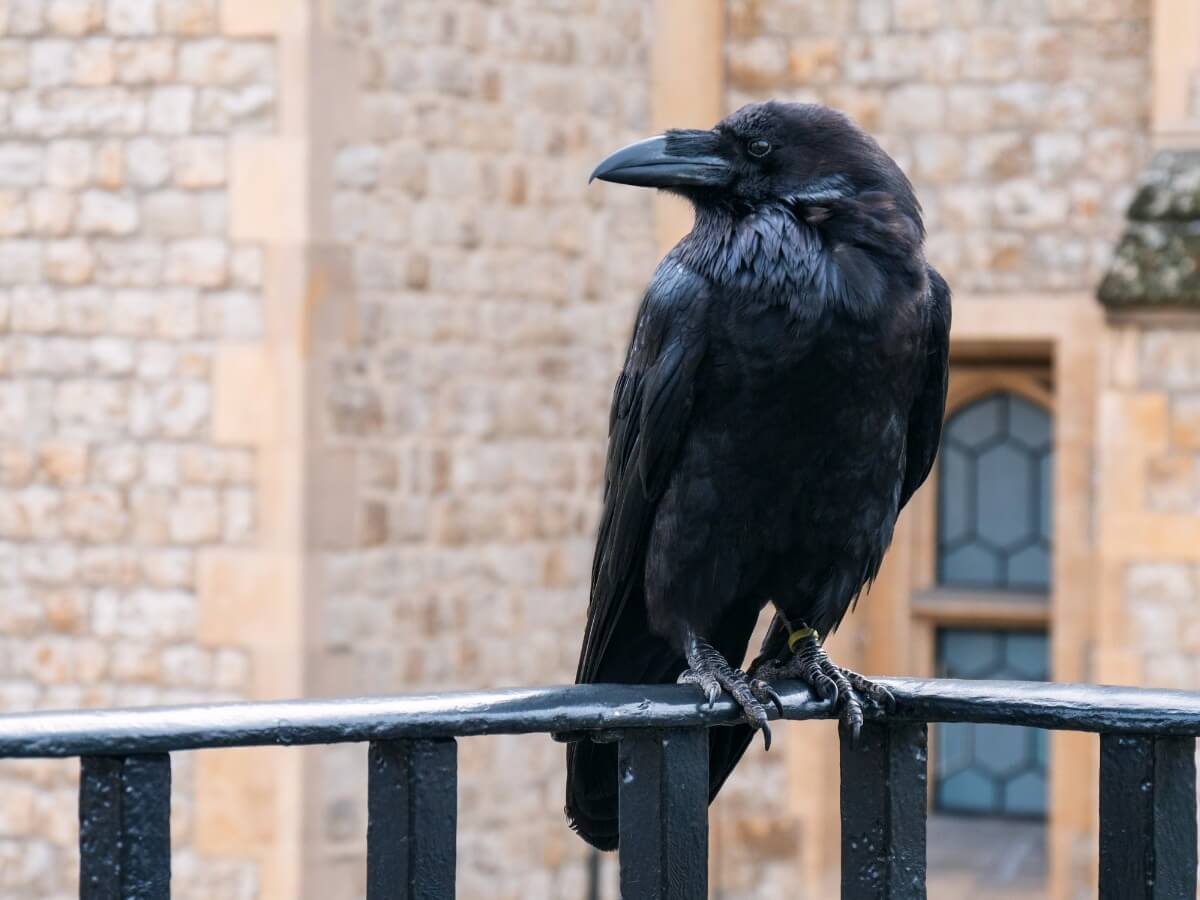The Common Raven: Habitat and Characteristics


Reviewed and approved by the biologist Samuel Sanchez
One of the world’s most popular birds is the common raven (Corvus corax). This bird is a major part of world literature as well as the mythology of several countries; its presence is mostly related to many myths and omens. However, this bird is defined beyond legends by its intelligence in nature.
Its behavior and communication make the common raven a very particular bird. Ravens belong to the order Passeriformes and are known for their ability to sing and imitate the human voice. Below you’ll find the most relevant information about this curious bird.
Habitat of the common raven
The common raven is one of the most widely distributed birds in the world. It covers a large part of the northern hemisphere and is present in northern Europe, the British Isles, Iceland, and northern Scandinavia. It’s also seen from East-Central Asia to the Pacific Ocean and from south of the Himalayas to northwest India.
In the Americas, these birds cover the entire region of Canada, the United States, and Mexico. They prefer open habitats such as treeless tundra, rocky cliffs, brushy deserts, and plains. However, they can exist in any ecosystem (with the exception of rainforests) and are frequently found in urban areas.

Physical characteristics
Common ravens boast beautiful black plumage, which can also have iridescent blue and purple highlights. The throat feathers are elongated and usually pale grey-brown; they’re called hackles and are used for communication.
Ravens are one of the largest passerines, with adult males measuring between 52 and 69 centimeters (1.7 to 2.2 feet) in length. In addition, Corvus corax has a sexual dimorphism in terms of its wingspan, with males measuring between 144 and 160 centimeters (4.7 to 5.2 feet) and females between 124 and 138 centimeters (4 to 4.5 feet). Their weight varies from 0.7 to 1.7 kilograms (1.5 to 3.7 pounds).
There are 8 known subspecies with few physical differences, although the most frequent are variations in the wedge shape of their tails, the thickness of their beaks, and their communication strategies. The bill of these birds is strong, black and slightly curved and their eyes have a dark brown iris.
The plumage of young ravens is similar to that of adults, but is duller. Their eye iris is usually greyish blue.
Common raven behavior
The common raven has high intelligence and complex social dynamics. It’s able to adapt to new problems in its natural environment and feeds in large groups in areas where resources are concentrated. On the other hand, individuals that fail to reproduce occupy communal shelters, although they usually live alone or in pairs.
Breeding pairs establish nesting territories, which vary according to the density of resources in the area. So far, there’s no evidence of migration in common ravens, although they may make shorter seasonal movements to avoid extreme winter weather.
Communication and perception
The common raven has a diverse set of calls and non-vocal sounds for different purposes. Experts have counted 15 to 33 categories of vocalizations in these birds, including alarm calls, comfort sounds, chase calls, and territorial tones.
Like other birds, common ravens can imitate the sounds of other animals and are capable of making a variety of sounds that closely resemble the calls of other birds. Females often generate some rustling sounds, and young birds engage in vocal games in which they display their entire repertoire of sounds for minutes (or hours) at a time.
Predation and feeding habits
Crows are rarely preyed upon, even when eggs or young are involved. Even so, adults fiercely defend their young by scaring off predators. These potential attackers may include large hawks and eagles, other ravens, owls, and martens.
Common ravens are omnivores that are primarily scavengers. Their food is of broad animal origin and includes arthropods, amphibians, small mammals, birds, reptiles, and carrion. They also feed on sheep placenta and plant foods include grains, fruits, and acorns.
Adults are wary of approaching new types of carrion, so they wait for other animals to arrive and approach food without fear.
Analysis of the stomachs of the common raven has shown that its diet consists primarily of mammalian meat, followed by insects and small birds. These birds take food from the ground and store all kinds of food such as bones, nuts, and meat. Younger birds begin experimenting with storing food soon after leaving the nest.
Common raven reproduction
Common ravens can mate at any time of the year, but this occurs most often during the fall and winter. These birds move in groups and pair for life, although there’s no evidence that they always mate with their mate. These pairs tend to be very territorial and nest almost always in the same place.
Young crows begin mating rituals at an early age, but will only mate after the first 2 or 3 years of life. This ritual consists of aerial acrobatics and demonstrations of skill to obtain food. Females invite copulation by crouching slightly and opening, spreading, or lowering their wings.
The common raven has a long life expectancy of 10 to 15 years in the wild and up to 40 years in captivity. However, most wild specimens die during their first years of life.
Crows also often shake or flap their tails and raise them slightly. After breeding, the common raven places its nest in large trees, on electric poles, or on old buildings. Egg-laying is between February and May, although clutches begin in March or April (with the female laying 3-7 eggs).
Eggs are pale blue-green with brown spots and incubate for 20-25 days. The parents make the nests with soft materials such as deer hair and sticks and have an asymmetrical appearance of 40 to 150 centimeters (15 to 60 inches) in diameter. The young leave the nest at 5-7 weeks of age, although they may stay with their family for a few weeks longer.
Conservation status
The common raven has been stigmatized throughout history and its relationship with humans is somewhat conflicted. From scarecrows to its role in different mythologies, it has been labeled as a noxious bird by the inhabitants of many regions. Consequently, the common raven has been persecuted and poisoned to prevent it from attacking crops or livestock.
Some populations of common ravens have been eliminated to protect other endangered species programs, as these birds were involved in predation. Currently, according to the International Union for Conservation of Nature (IUCN), its conservation status is “Least Concern (LC)”.

As you can appreciate, the common raven has very particular behavior patterns. Its communication and fidelity to its mate are just some of its distinctive features. However, it’s still a stigmatized species in the world and both literature and cinema strengthen this rejection with terror and mysticism.
One of the world’s most popular birds is the common raven (Corvus corax). This bird is a major part of world literature as well as the mythology of several countries; its presence is mostly related to many myths and omens. However, this bird is defined beyond legends by its intelligence in nature.
Its behavior and communication make the common raven a very particular bird. Ravens belong to the order Passeriformes and are known for their ability to sing and imitate the human voice. Below you’ll find the most relevant information about this curious bird.
Habitat of the common raven
The common raven is one of the most widely distributed birds in the world. It covers a large part of the northern hemisphere and is present in northern Europe, the British Isles, Iceland, and northern Scandinavia. It’s also seen from East-Central Asia to the Pacific Ocean and from south of the Himalayas to northwest India.
In the Americas, these birds cover the entire region of Canada, the United States, and Mexico. They prefer open habitats such as treeless tundra, rocky cliffs, brushy deserts, and plains. However, they can exist in any ecosystem (with the exception of rainforests) and are frequently found in urban areas.

Physical characteristics
Common ravens boast beautiful black plumage, which can also have iridescent blue and purple highlights. The throat feathers are elongated and usually pale grey-brown; they’re called hackles and are used for communication.
Ravens are one of the largest passerines, with adult males measuring between 52 and 69 centimeters (1.7 to 2.2 feet) in length. In addition, Corvus corax has a sexual dimorphism in terms of its wingspan, with males measuring between 144 and 160 centimeters (4.7 to 5.2 feet) and females between 124 and 138 centimeters (4 to 4.5 feet). Their weight varies from 0.7 to 1.7 kilograms (1.5 to 3.7 pounds).
There are 8 known subspecies with few physical differences, although the most frequent are variations in the wedge shape of their tails, the thickness of their beaks, and their communication strategies. The bill of these birds is strong, black and slightly curved and their eyes have a dark brown iris.
The plumage of young ravens is similar to that of adults, but is duller. Their eye iris is usually greyish blue.
Common raven behavior
The common raven has high intelligence and complex social dynamics. It’s able to adapt to new problems in its natural environment and feeds in large groups in areas where resources are concentrated. On the other hand, individuals that fail to reproduce occupy communal shelters, although they usually live alone or in pairs.
Breeding pairs establish nesting territories, which vary according to the density of resources in the area. So far, there’s no evidence of migration in common ravens, although they may make shorter seasonal movements to avoid extreme winter weather.
Communication and perception
The common raven has a diverse set of calls and non-vocal sounds for different purposes. Experts have counted 15 to 33 categories of vocalizations in these birds, including alarm calls, comfort sounds, chase calls, and territorial tones.
Like other birds, common ravens can imitate the sounds of other animals and are capable of making a variety of sounds that closely resemble the calls of other birds. Females often generate some rustling sounds, and young birds engage in vocal games in which they display their entire repertoire of sounds for minutes (or hours) at a time.
Predation and feeding habits
Crows are rarely preyed upon, even when eggs or young are involved. Even so, adults fiercely defend their young by scaring off predators. These potential attackers may include large hawks and eagles, other ravens, owls, and martens.
Common ravens are omnivores that are primarily scavengers. Their food is of broad animal origin and includes arthropods, amphibians, small mammals, birds, reptiles, and carrion. They also feed on sheep placenta and plant foods include grains, fruits, and acorns.
Adults are wary of approaching new types of carrion, so they wait for other animals to arrive and approach food without fear.
Analysis of the stomachs of the common raven has shown that its diet consists primarily of mammalian meat, followed by insects and small birds. These birds take food from the ground and store all kinds of food such as bones, nuts, and meat. Younger birds begin experimenting with storing food soon after leaving the nest.
Common raven reproduction
Common ravens can mate at any time of the year, but this occurs most often during the fall and winter. These birds move in groups and pair for life, although there’s no evidence that they always mate with their mate. These pairs tend to be very territorial and nest almost always in the same place.
Young crows begin mating rituals at an early age, but will only mate after the first 2 or 3 years of life. This ritual consists of aerial acrobatics and demonstrations of skill to obtain food. Females invite copulation by crouching slightly and opening, spreading, or lowering their wings.
The common raven has a long life expectancy of 10 to 15 years in the wild and up to 40 years in captivity. However, most wild specimens die during their first years of life.
Crows also often shake or flap their tails and raise them slightly. After breeding, the common raven places its nest in large trees, on electric poles, or on old buildings. Egg-laying is between February and May, although clutches begin in March or April (with the female laying 3-7 eggs).
Eggs are pale blue-green with brown spots and incubate for 20-25 days. The parents make the nests with soft materials such as deer hair and sticks and have an asymmetrical appearance of 40 to 150 centimeters (15 to 60 inches) in diameter. The young leave the nest at 5-7 weeks of age, although they may stay with their family for a few weeks longer.
Conservation status
The common raven has been stigmatized throughout history and its relationship with humans is somewhat conflicted. From scarecrows to its role in different mythologies, it has been labeled as a noxious bird by the inhabitants of many regions. Consequently, the common raven has been persecuted and poisoned to prevent it from attacking crops or livestock.
Some populations of common ravens have been eliminated to protect other endangered species programs, as these birds were involved in predation. Currently, according to the International Union for Conservation of Nature (IUCN), its conservation status is “Least Concern (LC)”.

As you can appreciate, the common raven has very particular behavior patterns. Its communication and fidelity to its mate are just some of its distinctive features. However, it’s still a stigmatized species in the world and both literature and cinema strengthen this rejection with terror and mysticism.
All cited sources were thoroughly reviewed by our team to ensure their quality, reliability, currency, and validity. The bibliography of this article was considered reliable and of academic or scientific accuracy.
- Berg, R. 1999. “Corvus corax” (On-line), Animal Diversity Web. Recogido el 12 de octubre de 2021 de: https://animaldiversity.org/accounts/Corvus_corax/
- SEOBridLife. Cuervo grande. Recogido el 14 de octubre de 2021 de: https://seo.org/ave/cuervo/
This text is provided for informational purposes only and does not replace consultation with a professional. If in doubt, consult your specialist.








